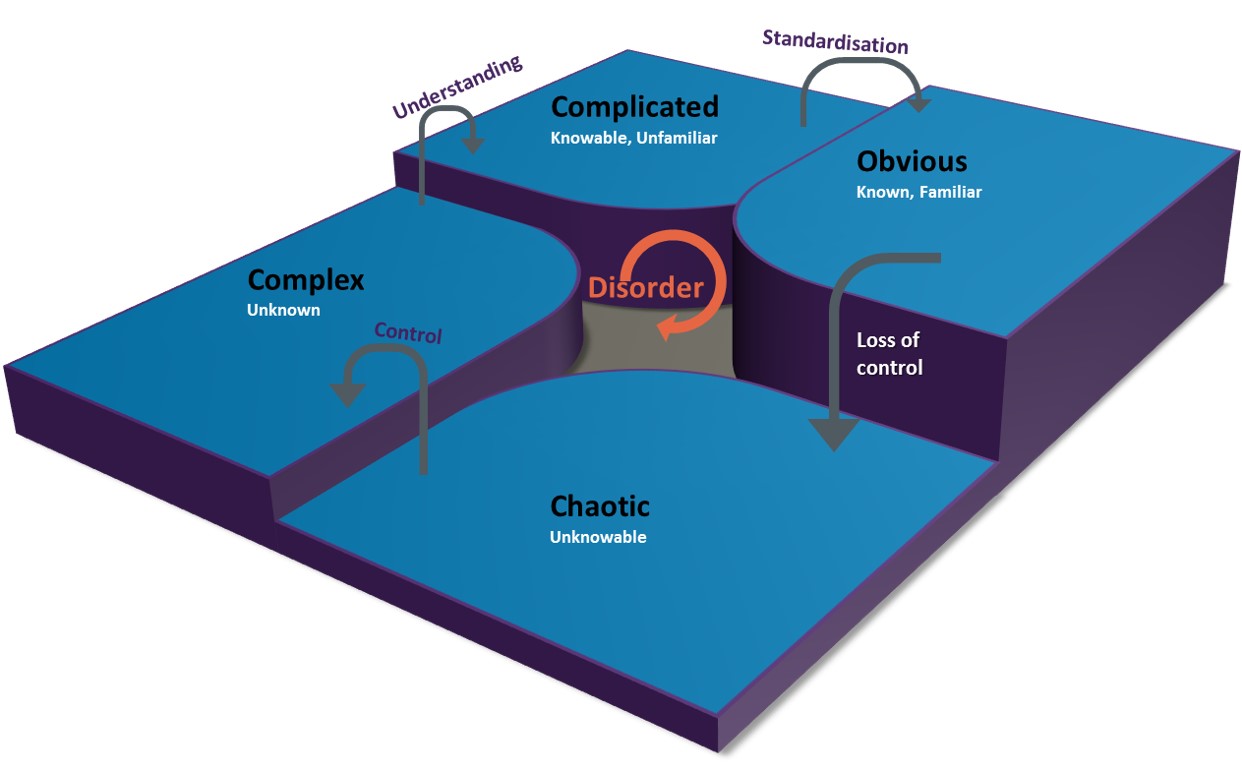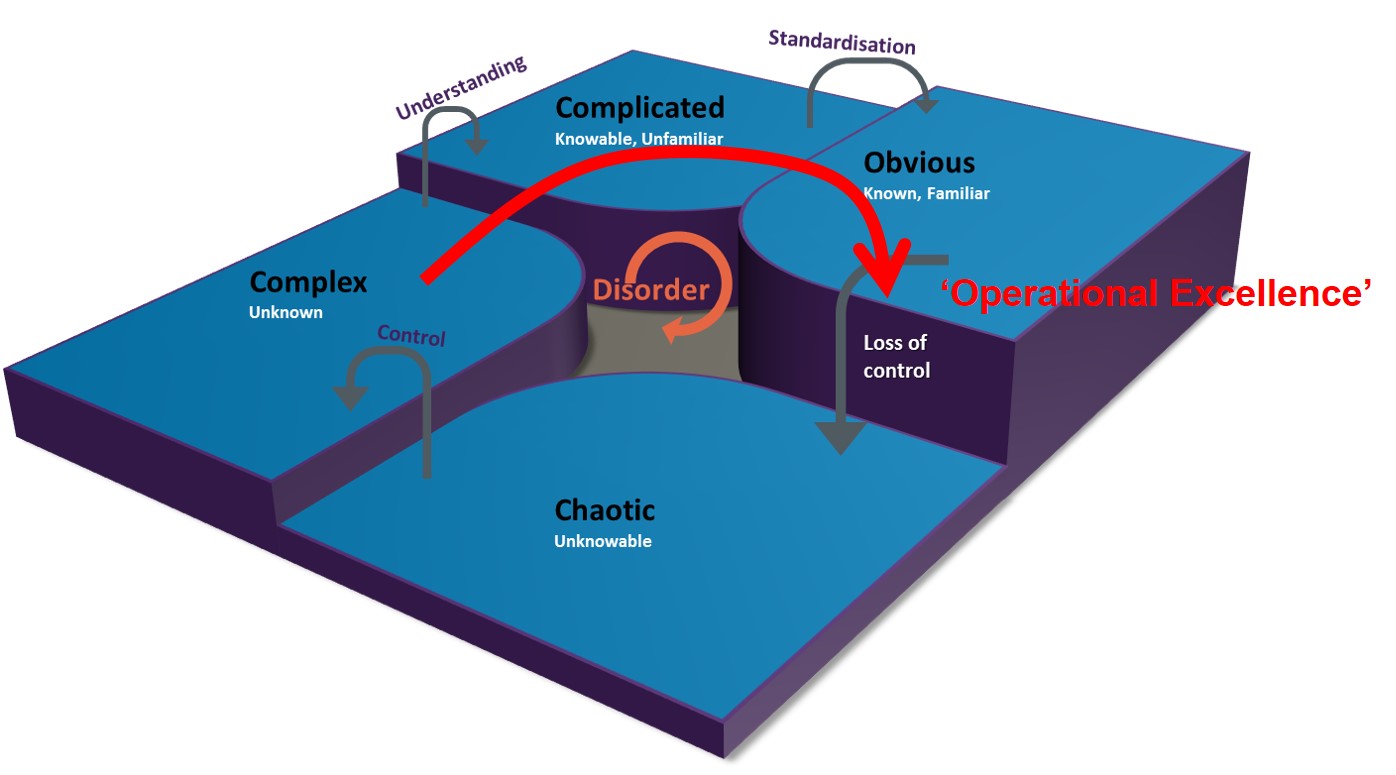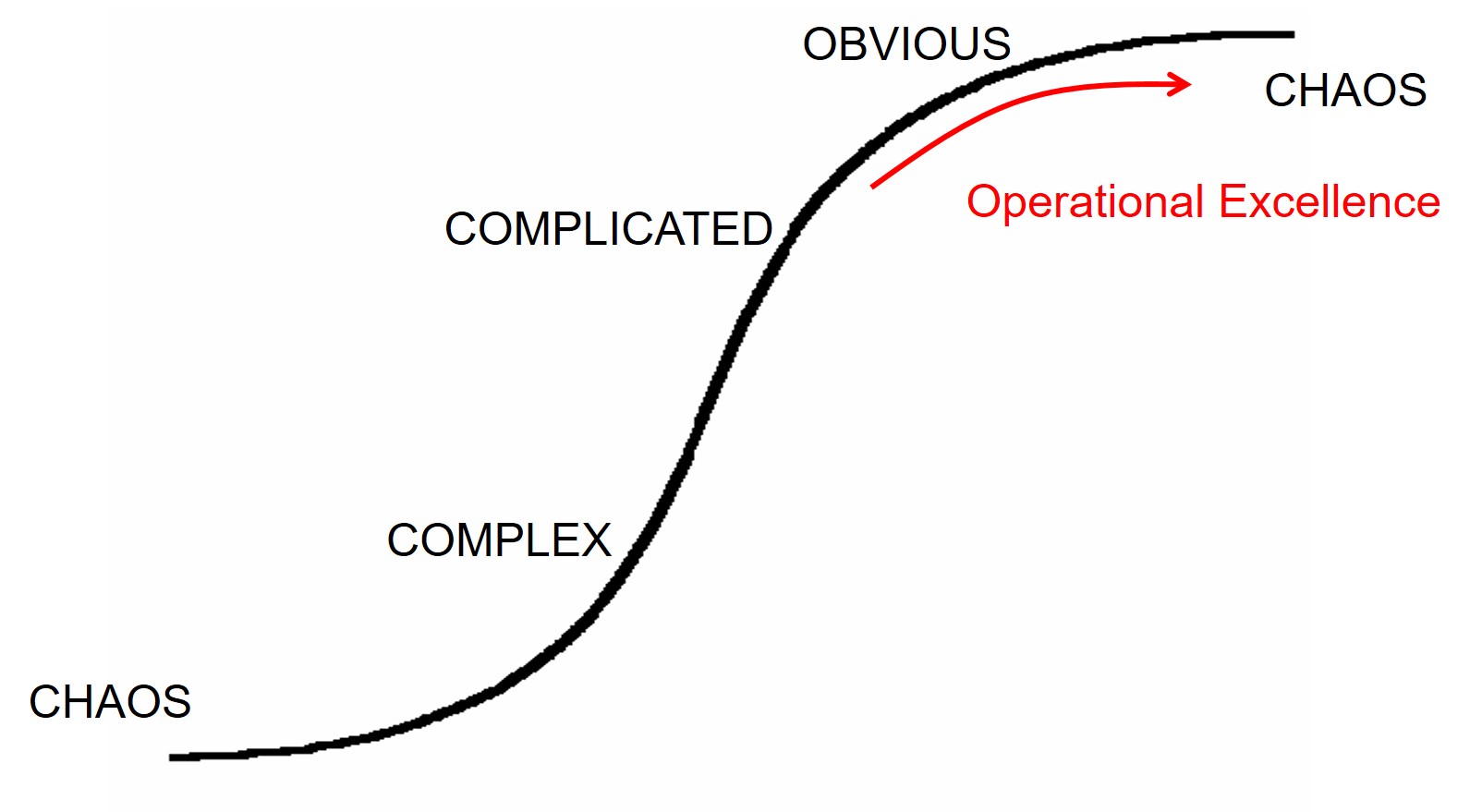I often find myself showing a copy of Dave Snowden’s Cynefin model when I need to explain some of the challenges of innovation. People seem to instinctively ‘get it’. Especially when I use this three-dimensional version of the model:
It’s great beauty – the thing that seems to resonate most with prospective innovators struggling to cope with their ‘Operational Excellence’ colleagues – is the cliff-edge between ‘Obvious’ and ‘Chaos’. The effect becomes amplified when we think about Operational Excellence as a way of thinking that seeks to ‘manage’ situations that are inherently complex through a strategy of simplification. Ever since F.W. Taylor, the prevailing logic has been that its only possible to scale businesses by segmenting work into small chunks that are easily trainable into new employees. Looked at through the Cynefin lens, Taylor’s efforts can be seen as a series of scientific studies to understand each given operation in a process, such that everything could be cropped down to a very simple set of instructions. Taylor worked out the optimum size of shovel so that a novice shoveller could become productive almost immediately after they picked it up. Taylor’s view when talking to the shovellers was, ‘I’m here to make your job easier for you’. When he was selling his process to the managers, on the other hand, he was effectively saying, ‘we don’t need workers with brains, I’ve done all the necessary thinking for them’. In Cynefin terms, Taylorism specifically, and ‘Operational Excellence in general can be seen as a management strategy that looks like this:
What Taylor didn’t understand, and what most Operational Excellence people still don’t usually understand (at least until its too late) is that their efforts are optimizing systems to the edge of chaos. Nearly all of 430 Fortune500 companies from 1950 that no longer exist, disappeared because they fell off this cliff. They ‘always did what they’d always done’ because it was efficient to do so. Within their bubble at least. The only problem was that the world outside that bubble had moved on. They hadn’t understood that in a complex environment like ‘the market’, if you always do what you’ve always done, you can only legitimately expect that you will probably get what you’ve always got.
As more and more enterprises become aware of complexity, they slowly begin to realise that Operational Excellence is a temporary, stop-gap answer. One of the strongest signals of this awareness is the current vogue for ‘Design Thinking’. Especially with the management community… designers, good ones at least, inherently understand complexity and ‘do’ design thinking naturally. Managers for the most part don’t. Until they’ve spent a week at a D.School and ‘see the light’. Divergence and experimentation are the order of the day. Most Design Thinking educators might not know that they’re doing it, but when we look at Design Thinking through the Cynefin lens, we see that it is attempting to reverse the killer effects of Operational Excellence. Design Thinking is about embracing complexity:
It’s not clear to me yet that Design Thinking will help save the day as far as many enterprises are concerned. Partly because it has typically been presented in a stand-alone faddish manner, and partly because when new users attempt to dig below the surface, there’s not an awful lot of usable content. Not to mention that an awful lot of it is a crude re-badging of Edward De Bono’s work (clue: look at all of the ‘Big’ Design Thinkers – they’re all British and were all raised at a time when, if you were interested in creativity, you inevitably found yourself reading The Mechanism Of Mind and its surrounding family of books).
I think Cynefin has a role to play in helping to solve this ‘save the day’ problem. Especially when we connect the Cynefin model to the evolutionary S-Curve.
Operational Excellence, in S-Curve terms, is all about climbing the current curve. Combine this idea with the different stages of Operational Excellence as emerge from th Cynefin model and the S-Curve climbing journey looks something like this:
At the start of a new-S-curve, Chaos reigns. Lots of prospective innovators are trying to find a new solution and most will fail.
Eventually one or two ‘lucky ones’ will prevail. They’ll find ‘a’ solution that is good enough to attract one or two brave early customers. There are no processes or protocols, so provider and customer need to be engaged in a mutually beneficial dance to evolve the solution to a point where it becomes worth the investment of everyone’s time and money. ‘Fail fast, fail forward’, and other complexity-consistent strategies are brought into play. Thought of in terms of the Hype Cycle, this period of evolution is all about peaks of over-inflated expectation and troughs of despondency.
And then, if everyone pulls together well enough, the solution finds itself transcending a tipping point. Now it is useful enough that an increasing number of customers want the solution. Sales and Marketing teams get involved, and in order to help them sell the beautiful new solution, brochures get written and a sales process crystallises. ‘Understanding’ of how to sell and how to produce economically means the prevailing management strategy devolves to ‘complicated’.
Some time later, usually when the growth hits an inflexion point and the sales team start missing their targets, the focus shifts towards efficiency. Cut the bottom line. Along comes Lean and SixSigma, Value Stream Maps to try and squeeze every last drop of ‘waste’ from the system. The management strategy devolves further into the ‘obvious’.
…And keeps going, all the time things feeling more and more like a game of corporate whack-a-mole. Every time we try and improve one part of the system, it seems to have an adverse effect on some other part…
…the enterprise teeters ever closer to the edge of Chaos… no-one is able to improve the system any more, and those that are smart enough to understand what’s happening start to leave the stalled ship and go looking for lifeboats. Their chaotic search for the new solution is now on. The descent of the beautifully optimized old enterprise into chaos, on the other hand, is now merely a matter of time. The long established management team asleep at the wheel, safe in the knowledge that the operational excellence goals have been met, and their bonuses paid in full. It won’t be long ’til they’ve optimized the whole shebang full circle back into chaos.




